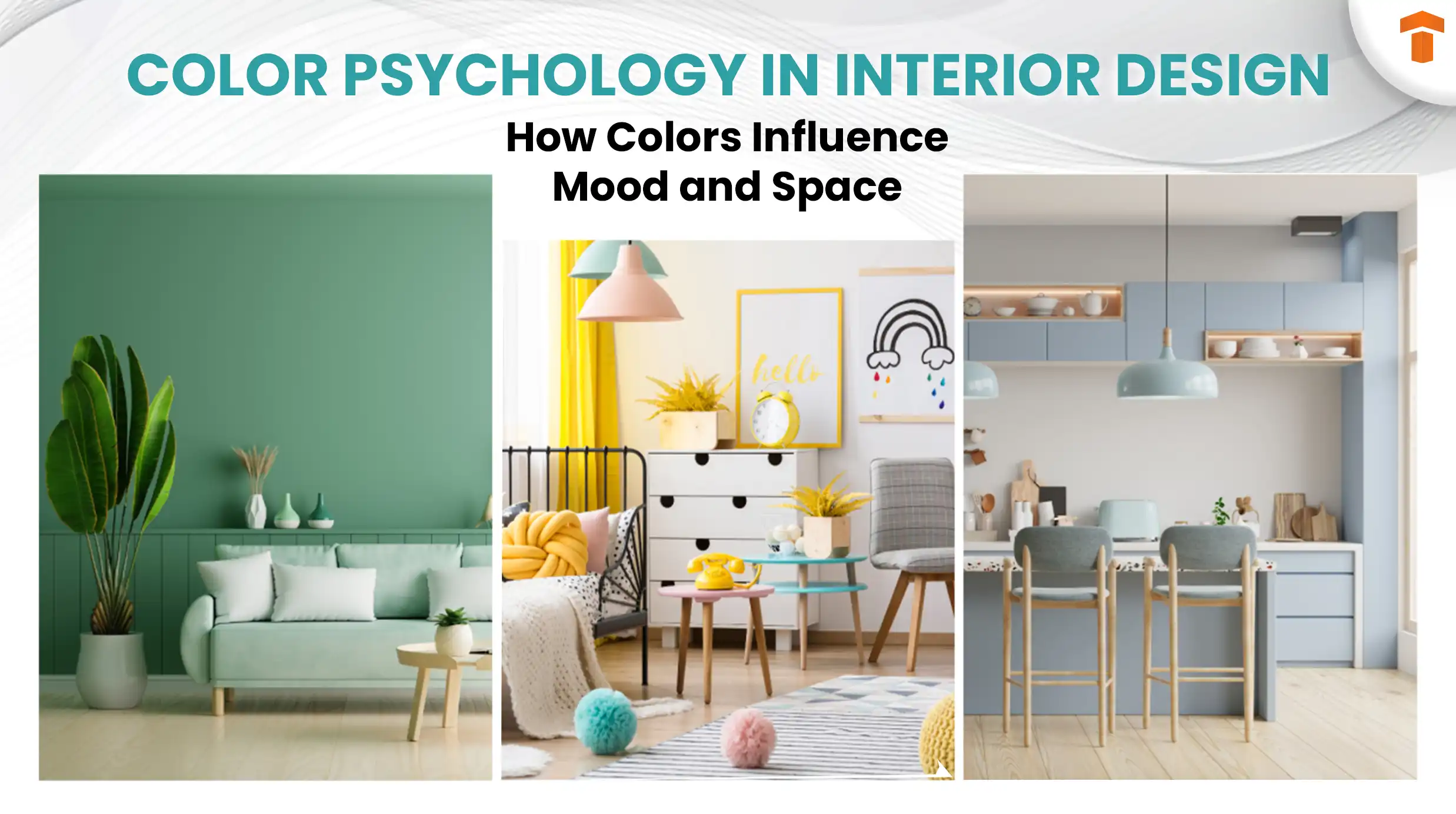Color Psychology in Interior Design: How Colors Influence Mood and Space
Sep 12, 2024
Category: Others
Admin

Ever walked into a room and just felt calm? Or walked into one that filled you with energy, wanting to live? Well, the magic lies in colors. Colors have an exceptional way of playing with our senses, changing the mood of any space, and influencing our total well-being.
Intentional color use can actually elicit feelings change mood and even affect behavioral patterns through interior design. Here is where color psychology in interior design comes in handy for both a designer and a homeowner. By understanding how colors work, you will create those spaces not only appealing but also feel right for their purpose.
The Impact of Color on Human Emotion
The moment one enters a room, color is the first thing to catch the eye: the soothing blue of the bedroom or the scintillating red in the restaurant. Color psychology in interior design affects the way we feel inside. Warm colors like red, orange, and yellow, create energy and warmth, while cool tones-a category that includes blue, green, and purple-promote calmness and relaxation.
According to studies, color psychology plays a very important role in mood according to interior design. Warm tones are red and orange shades that are energetic and warm; thus, they are very suitable for social areas, while cool tones including blues and greens offer relaxation and therefore are perfectly suitable for a bedroom or a bathroom.
All that comes into play when an interior designer picks certain colors to set the tone for restaurants, spas, and resorts. Restaurants use the color red to provoke appetite, while spas and resorts have used cool colors such as blue and green to instill a sense of calmness and tranquility.
Popular colors, their different effects on the spaces, and how they can be combined with other colors in choosing balanced home interior color schemes-let’s look into these ideas.
Warm Colors: Bringing Energy and Passion to Spaces
Red: The Color of Passion and Power
Red is one of the most exciting colors in the palette of interior design. The color elicits emotions of passion, energy, and strength. Red, though it could add life to a room, has to be used judiciously. In a living area or dining room, for instance, red helps to initiate conversation and energy, while in the bedrooms, it creates restlessness.
Using Red in Interior Design:
Living rooms/dining areas: Create interaction with red and add warmth.
Home offices: Red improves concentration and productivity, especially on tasks that require high level of energy
Yellow: Color of Happiness and Optimism
The color yellow is a happy color due to its association with the sun. The color will bring joy in whatever room it will be used. It works effectively in the kitchen, dining, and entryways since it adds warmth and gives rooms an energetic feel.
But when yellow is overused, it can bring on frustration or anxiety. Harness the uplifting energy of yellow with its use as an accent color or by using it minimally on walls and furnishings.
Orange – The Color of Energy and Enthusiasm
Orange is energetic, positive, and warm, making it absolutely ideal for lively areas. It encourages talking and imagination; hence, it works wonders in the living room and dining area. In the home office, it can even increase motivation and drive.
You can balance orange with neutrals, such as white or gray, or cool tones, like blue, so the space does not feel overwhelming. As a brilliant color, the vivid brightness of orange can serve well in accents or feature walls, thus creating an invitingly vibrant atmosphere.
Cool Colors: Creating Calm and Tranquility
Blue: Color of Calm and Focus
Blue is the color most used when referring to relaxation. This color is ideal for bedrooms and bathrooms. It implies tranquility and induces in an individual a sense of trust, furthering its usage in corporate offices.
Blue in Interior Design Application
Bedrooms: This color will help in ensuring good sleep by using soft shades of this color.
Bathrooms: Usage of Lighter-colored tiles or accents will provide a spa-like environment for one to relax.
This is supported by numerous studies where the color blue is used to bring down stress and blood pressure; therefore, it is ideal to create an atmosphere where calm and focus prevail.
Green: The Color of Nature and Equilibrium
Green serves as a symbol for nature, balance, and even rebirth. It rejuvenates your senses by soothing them, thereby making this color one of the most sought-after colors in house interior design. Green blends well with almost every room in the house, from bedrooms to kitchens.
Green balances other colors in areas one would like to have some harmony, like a living room or study. This is also quite a good color to use for a home office, as it is said to enhance concentration.
Purple: The Color of Creativity and Luxury
Another cool tone would be purple, which adds to the space a feeling of creativity, luxury, and relaxation. Lighter shades, like lavender, are perfect in developing a calm, while the deeper shades, plum or royal purple, require opulence and grandeur.
How to Use Purple in Interior Design
Bedrooms: The lighter shades of purple are often used in bedrooms to achieve that peaceful and serene atmosphere which will be propitious for relaxation.
Living rooms: Deep purples can create a sumptuous, opulent atmosphere, especially with gold accents for added royalty. Purple stands out in places where creativity is stimulated, like a home office or studio, since it inspires imagination and originality.
| Also read- Design with Nature: Biomimicry in Architecture
Neutral Colors: Versatile Foundations
White: The Color of Purity and Simplicity
White lends an air of spaciousness and cleanliness. It is bland, allowing other design elements to stand out, such as colors of furniture and artwork. In minimalist designs, white acts as a primer to keep the look tidy and clutter-free.
Too much white can make a room feel cold or sterile, so it is best used in small amounts and offset with several warmer accent pieces, including wood tones or soft textiles.
Gray: The Modern Neutral
Gray has become the immediate go-to neutral in most interior design settings today. It can play the subtle backdrop role with ease or be front and center. Light grays inspire calm and sophistication, while deeper grays can evoke depth and even drama in a room.
Gray is also often balanced with metallics and color accents to keep things modern and sleek, adding visual interest to an interior space.
Black: The Colour of Sophistication and Elegance
Black, or power, elegance, and luxury-in itself, is a powerful choice in interior design. It can be used to make any space dramatic or minimalist. Black will add richness, contrast, and an air of mystery when applied correctly in the making of the interior.
Living rooms and bedrooms: Black can be used as an accent color, highlighting such things as furniture or artwork against a highly sophisticated backdrop. Bathrooms: The use of matte black fixtures is modern, while black tiles or walls create an intimate, luxuriant atmosphere.
However, black should be combined with lighter colors so that the room is not confined or suffocating. White, metallic tones, or neutral tones soften its powerful tone into a beautiful contrast.
How to Choose the Right Color Palette
Choosing the right color scheme is much more than just your personal preference. In creating a cohesive design, here’s a run-through on color psychology in interior design based on the following aspects:
Room Function
The purpose differs from one room to the other, even in your house. Different colors should be chosen; for instance, yellow and orange are quite lively and can be applied in areas where there is more interaction while tones of blue or green will do well in the bedrooms.
Natural Light
Natural light has much to do with color appearances. A very sunny room is capable of handling a dark, rich shade in color, but a poorly lit room can make it appear even smaller with colors that make them seem enclosed.
Complementary Colors
A successful color scheme will balance warmth with coolness so that a room is not one-dimensional or overwhelming. Monochromatic schemes also use different shades of one color for depth and interest in rooms visually.
Role of Accent Color
Accent colors are the finishing touches that put life into your room. They are used in designing rooms in order to draw one’s attention to any particular part of the room or any detail in it. Accent color can be added by using throw pillows, artwork, or even small furniture pieces.
In such a case, a neutral room may require a bright red or yellow shade that itself may turn into the focal point of the area. In contrast, a vibrant room would call for the addition of soft accents in neutral shades to reach a certain semblance of balance.
In a Nutshell
Color psychology, which is the study of colors and their effects on human feelings, plays a very important part in interior design, letting you create a certain atmosphere that evokes the right emotions and moods. By selecting colors considerately using psychological principles, you have the chance to make an interior not only very beautiful but also healthy.
Be it a cozy bedroom or a vibrant living room, the effective use of color can dramatically change how a space feels and functions. Warm colors bring energy, red and yellow evoke vibrant action, whereas cool colors like blues and greens, do not. Whites and grays are neutrals that balance and allow many other options to be added, hence making them indispensable in any palette of colors.
FAQs
Q1. What is the psychology of color in interior design?
Ans. Color psychology of interior design is concerned with the study of how colors may influence the consciousness, feeling, or mood of people inside a space. Through color psychology, an interior designer creates a specific atmosphere or mood in a room with the aim of optimizing such a space for the users.
Q2. What are the 7 elements of interior design?
Ans. They’re Space, Line, Light, Colour, Form, Texture and Pattern.
Q3. What is the color rule interior?
Ans. This decoration rule suggests that one should paint their room 60% with a dominant color, 30% with a secondary color, and 10% with an accent shade. It is all about getting the right tone balance. Choose colors that can gel well to result in a subtle combination.








